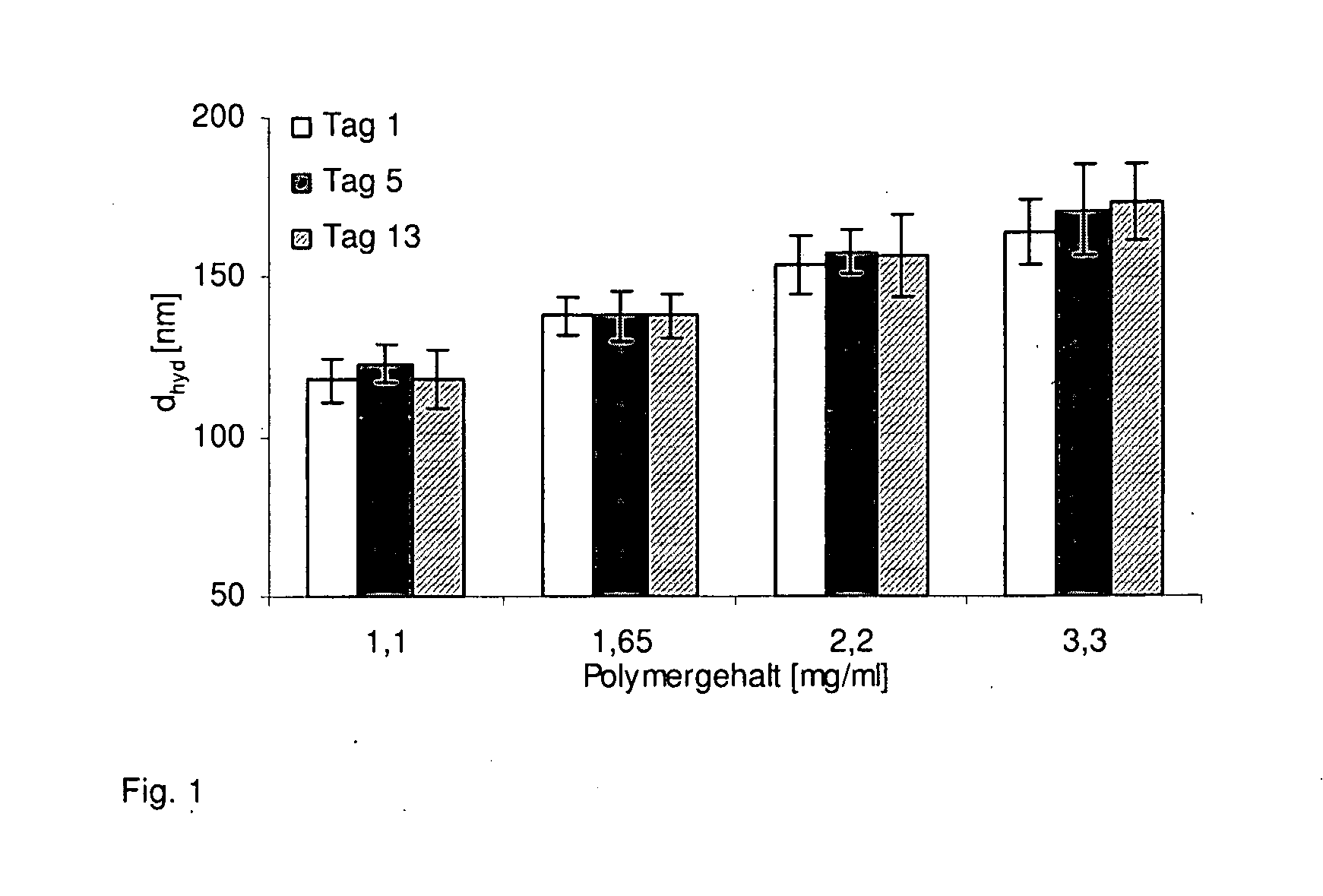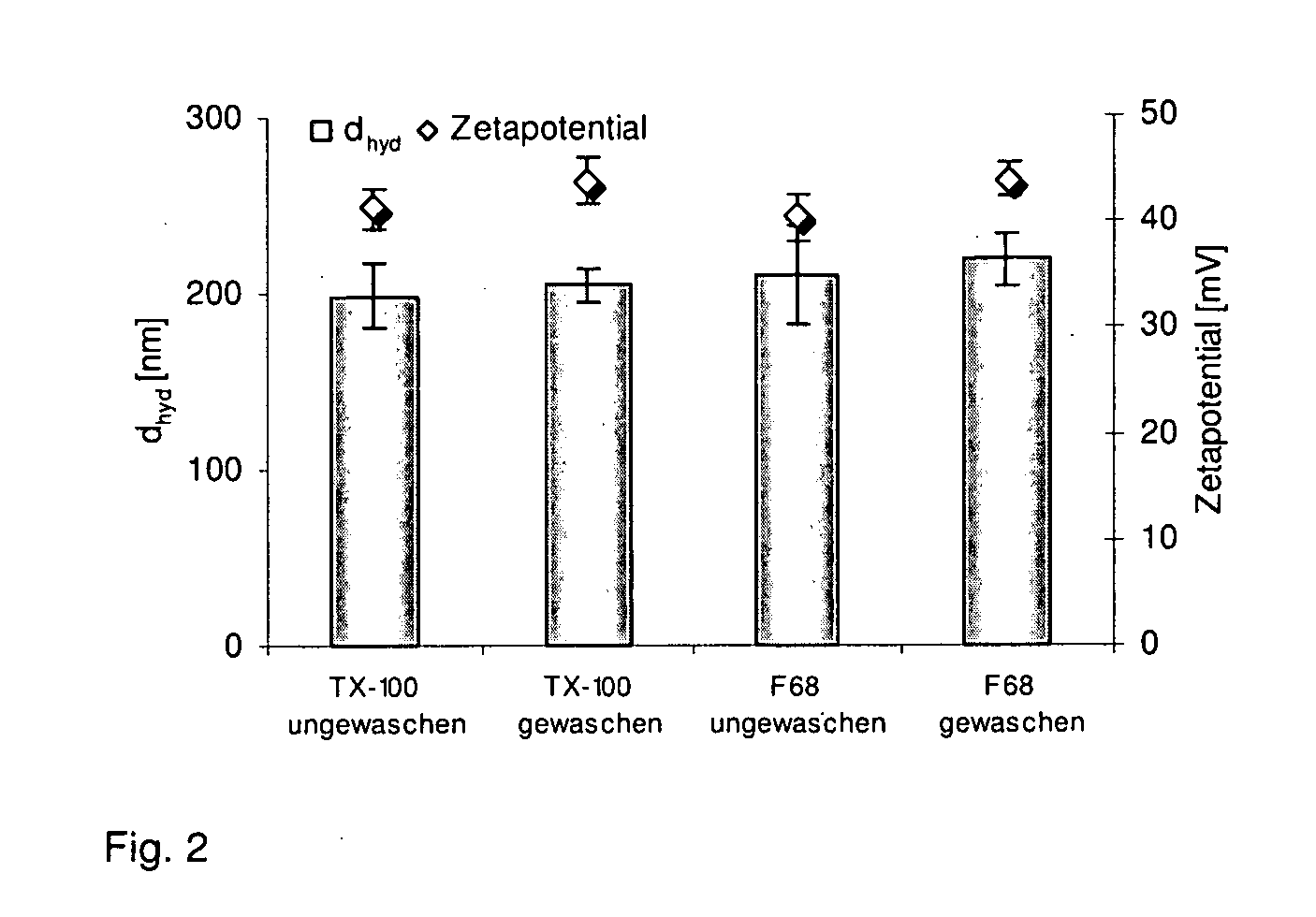Functionalized solid polymer nanoparticles for diagnostic and therapeutic applications
a technology of solid polymer nanoparticles and diagnostics, applied in the direction of peptide/protein ingredients, peptide delivery, echographic/ultrasound-imaging preparations, etc., can solve the problems of cell possesses very effective, all the body's rapidly dividing cells, including tumor cells, damage, etc., and achieve maximum flexibility and facilitate modification
- Summary
- Abstract
- Description
- Claims
- Application Information
AI Technical Summary
Benefits of technology
Problems solved by technology
Method used
Image
Examples
example 1
Production of PBCA by Anionic Polymerization
[0151]Sicomet 6000 is used for PBCA production by anionic polymerization of butylcyanoacrylate (BCA). The polymerization process is carried out by slow, permanent dropwise addition of a total of 2.5% [w / v] BCA to a 1% [w / v] Triton X-100 solution at pH 2.2. The pH value is adjusted beforehand by means of a 0.1N HCl solution. The resultant dispersion is stirred at a constant 450 rev / min while cooling on an ice bath (approx. 4° C.) for 4 hours. Then larger agglomerates are removed by filtration through a pleated paper filter. By adding ethanol, the BCA polymerized to PBCA is precipitated and the filter residue obtained from it is washed several times with purified water (MilliQ system). After drying the PBCA filter residue in a drying cabinet at 40° C. for 24 h, an average molecular weight is determined by GPC (Mn ˜2000 Da). Polysterol standards are used.
example 2
Production of Functionalized PBCA Nanoparticles by Nanoprecipitation
[0152]i) PBCA-P(DMAEMA) Nanoparticles
[0153]500 μl of a 2% acetone PBCA solution [w / v] is mixed thoroughly with 100 μl of a 2% acetone P(DMAEMA) solution [w / v] in closed conditions (to prevent evaporation of the acetone) using a standard laboratory shaker. The PBCA used for this is prepared according to Example 1. 100 μl of each of the dye solutions described in the following is added to this polymer mixture.
[0154]Dye solution a: 3 mg of Indocyanine Green is first dissolved in 300 μl of purified water in the ultrasonic bath, and then 700 μl acetone is added.
[0155]Dye solution b, c, d: The dyes DODC, IDCC and Coumarin 6 are used in a 0.02% acetone solution [w / v].
[0156]The thoroughly mixed dye-polymer mixture is taken up in a 2.5 ml Eppendorf pipette and pipetted into 10 ml of a vigorously stirred 1% [w / v] Synperonic T707 solution. The nanoparticle dispersion is stirred for 2 h at 600 rev / min (standard magnetic stirrer...
example 3
Influencing Nanoprecipitation by Varying the Polymer Content in the Surfactant Phase
[0162]It is shown in FIG. 1 that the particle size of the PBCA-P(DMAEMA) nanoparticles can be controlled during production by varying the polymer concentration. PBCA-P(DMAEMA) nanoparticles produced according to Example 2 are stabilized with the surfactant Synperonic T707. During particle production (nanoprecipitation), the volume of the organic polymer solution injected into the surfactant phase is kept constant and only the polymer concentration is varied correspondingly. All the other production conditions (surfactant concentration, ratio of polymers PBCA:P(DMAEMA)=10:1, dye concentration, temperature, stirring speed / magnetic stirring bar, vessel, type of injection) remain constant.
[0163]The use of a lower polymer concentration in the surfactant phase during precipitation leads to smaller particle diameters. Over the test period, no change in particle size was found at equal polymer content.
PUM
| Property | Measurement | Unit |
|---|---|---|
| size | aaaaa | aaaaa |
| size | aaaaa | aaaaa |
| size | aaaaa | aaaaa |
Abstract
Description
Claims
Application Information
 Login to View More
Login to View More - R&D
- Intellectual Property
- Life Sciences
- Materials
- Tech Scout
- Unparalleled Data Quality
- Higher Quality Content
- 60% Fewer Hallucinations
Browse by: Latest US Patents, China's latest patents, Technical Efficacy Thesaurus, Application Domain, Technology Topic, Popular Technical Reports.
© 2025 PatSnap. All rights reserved.Legal|Privacy policy|Modern Slavery Act Transparency Statement|Sitemap|About US| Contact US: help@patsnap.com



